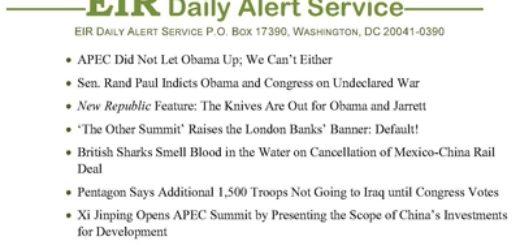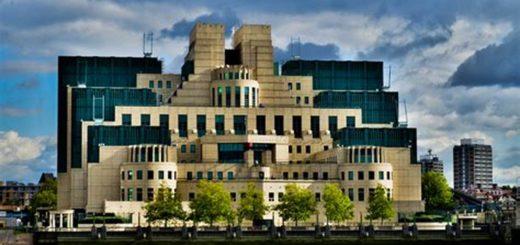EIR Daily Alert Service, FRIDAY, January 3, 2020
FRIDAY, JANUARY 3, 2020
Volume 7, Number 2
EIR Daily Alert Service
P.O. Box 17390, Washington, DC 20041-0390
- Join Us To Remove a Rotten Establishment in 2020
- The Goldman Whale: Insured Deposit Bank’s Wild Derivative Gambles
- Battle Over U.S. Troops in Iraq Shifts From the Streets to the Parliament
- Turkish Parliament Approves Government Motion for Libya Troop Deployment, Amid Opposition
- Kim Jong Un Appears To Close North Korea-U.S. Negotiations Door, But Not Slam It
- Presidents Zelensky and Putin Have Year-End Phone Call
- Multiple Nations Readying Midsummer Launches to Mars
- Roscosmos Plans Lunar Base To Track Objects in Strategic Defense of Earth
- China Aims To Launch 20 More High-Speed Rail Lines in 2020
EDITORIAL
Join Us To Remove a Rotten Establishment in 2020
Jan. 2 (EIRNS)—On Nov. 9, 2016, the American economist Lyndon LaRouche said that the welcome defeat of Hillary Clinton was not an American, but a truly worldwide event. Not just Americans, but the world had now rejected her, her policies and her backers.
He was right.
For three years we have seen this playing itself out among mass forces, not just in the United States, but in nations of every continent (except possibly Antarctica). The Brexit vote in Britain in 2016 and Donald Trump’s election were the first manifestations. Over the subsequent years they were followed by waves of strikes and mass protests nearly everywhere. The ultimate targets were the trademarked policies of Hillary Clinton and the whole rotten liberal establishment: globalization and free trade. Globalization and free trade had destroyed nation after nation. But it was not simply out of desperation that citizens protested and struck—gradually, over the period since 2016, clearer or vaguer ideas of possible better alternatives had seeped into popular consciousness as well. The strike wave responded not only to oppression, but also to an intuition of hope that desperate circumstances might somehow be changed.
On the other side, the “establishment” which is fighting to the last ditch to reverse the 2016 election in the U.S., has imported the tool of “total information warfare” from the Anglo-American Ukraine coup of 2014. They use the Internet to dominate discourse and spy on dissidents. A closer look shows that establishment is an incestuous entanglement among corrupt academia, the mass news and entertainment media, and donor-dependent party hacks, as Lyndon LaRouche wrote already in 1998.
But the Establishment is not its own master. As Lyndon LaRouche showed over decades, and as we freshly showed again in 2017 in our Robert Mueller pamphlet, this decadent liberal establishment, like Wall Street which runs it in large part, is a puppet of the modern-day British Empire headquartered in the City of London. (See “Robert Mueller Is an Amoral Legal Assassin: He Will Do His Job If You Let Him,” EIR, Sept. 29, 2017.)
The “deplorables” who elected Donald Trump in 2016, and who are now battling a three-year effort to overturn that election, are fighting the same adversary we fought in 1775-83, and fought in various guises thereafter. Nor was that a strictly American matter. The struggle which began on these shores under John Winthrop and the Mathers, was the product of the greatest thinkers of Europe, who shared the vision of the Platonist republicans of antiquity, of a new, far-away settlement where republican government fit for human beings could be established out of reach of the oligarchs of Europe.
And America’s founders knew that one day, if the experiment succeeded, America would become one link in a chain of free republics eventually circling the globe. America’s emergence from the Civil War as an industrial giant brought this closer, and Presidents Lincoln, Grant and McKinley pushed towards it.
Franklin Roosevelt understood this completely, including its essential economic aspect. During the 1930s, not only did he outlaw U.S. “gunboat diplomacy” against the neighbor nations of the Americas, but he also sought to cooperatively develop and industrialize them, while preserving their perfect sovereignty. (See “The Good Neighbor Policy and Brazil: Roosevelt’s Bold Creation of the Anti-Entropic Bretton Woods System,” EIR, Sept. 6, 2019.)
Even before the U.S. entered World War II, Roosevelt was actively planning a postwar peace which would not merely prepare for another imminent war as the Versailles Treaty had done after World War I. Instead, he projected a postwar world free of empire, under a new international credit system, his original design of the Bretton Woods institutions (World Bank and IMF), which would especially facilitate massive flows of secured credit for capital exports from “developed” nations to the “underdeveloped,” or from the global “North” to the “South,” as we sometimes say today. Combined development of global prosperity, rather than persistent misery for most of humanity. But Roosevelt’s plan was increasingly perverted after his death.
For decades, Lyndon LaRouche explained and expounded an updated version of Franklin Roosevelt’s plan as a “New Bretton Woods” agreement among the United States, Russia, China and India. These four nations together can take on and overthrow the British financial empire in this way. As Roosevelt foresaw, this will be the end of empire.
President Donald Trump’s attendance at the 75th anniversary commemoration of the linking-up of Russian and U.S. troops on the Elbe River this April 25, should be a link in this chain, and likewise his participation in the V-E Day celebrations in Moscow on May 9.
COLLAPSING WESTERN FINANCIAL SYSTEM
The Goldman Whale: Insured Deposit Bank’s Wild Derivative Gambles
Jan. 1 (EIRNS)—In the third quarter, Goldman Sachs’ federally insured commercial banking unit, Goldman Sachs Bank USA—which this investment bank was permitted to open only in the Federal Reserve’s crazed responses to the 2008 financial crash—engaged in gargantuan speculation in derivatives markets backed by depositors’ funds. It lost $1.24 billion trading in interest-rate swaps; and made $1.14 billion gambling in foreign exchange (forex) derivatives.
This wild speculation was engaged in by a bank which, over a decade, has managed to lure in about $150 billion in deposits—one-tenth to one-fifteenth of Wall Street’s biggest giants. But with that deposit base, Goldman Sachs Bank USA has become exposed to $49 trillion in notional value of derivatives; its value at risk alone, in derivatives markets, is close to $1 trillion, based on total deposits of one-sixth that, equity capital of one-fortieth.
While that was going on, bank lending to U.S. businesses—“commercial and industrial lending”—fell by 4% in 2019, with the biggest banks leading the drop, as business capital investment stagnated. Businesses instead went to the junk bond markets if they could, and junk issuance rose 60% in 2019.
The outrageous crash-mongering on Wall Street was exposed in the Dec. 26 “Wall Street on Parade” column of Pam and Russ Martens. They quote Phil Angelides, then-Chair of the Financial Crisis Inquiry Commission (FCIC), at a June 30, 2010 hearing to examine “The Role of Derivatives in the Financial Crisis”: “As the financial crisis came to a head in the fall of 2008, no one knew what kind of derivative-related liabilities the other guys had. Our free markets work when participants have good information. When clarity mattered most, Wall Street and Washington were flying blind…. In June 2008, Goldman’s derivative book had a stunning notional value of $53 trillion.”
And then the banks stopped lending to each other over “counterparty risk,” and the Fed started gushing out “liquidity loans” everywhere.
The only difference today is that Goldman was given a federally insured deposit bank to gamble with. The conduct flies against not only the Glass-Steagall Act, but also Section 23A of the Federal Reserve Act of 1913. That section was added to the 1913 Act by the later Glass-Steagall Act, so it is still “in force”—if it were enforced. It prohibits a bank holding company from placing “low quality”—i.e., speculative or illiquid—securities on the books of a federally insured unit.
STRATEGIC WAR DANGER
Battle over U.S. Troops in Iraq Shifts from the Streets to the Parliament
Jan. 2 (EIRNS)—Calm apparently returned to the Green Zone in Baghdad including the U.S. Embassy compound, when protesters withdrew yesterday afternoon, reportedly in response to orders from the leadership of the Popular Mobilization Commission, which oversees the Shi’ite militias known as the Hashd al Shaabi. According to AFP, the Hashd called on its supporters to leave the embassy and regroup outside the Green Zone “out of respect for the state…. You delivered your message,” it said in a statement. AFP’s photographer saw protesters dismantling their tents andleaving the Green Zone. Kataeb Hezbollah, the group targeted by U.S. air strikes on Dec. 29, initially told AFP it would stay at the embassy, but later said it had decided to abide by the Hashd order. “We scored a huge win: we arrived to the U.S. embassy, which no one had done before,” spokesman Mohammad Mohyeddin told AFP.
Kataeb Hezbollah and other Shi’ite militias represented by the major political factions in Baghdad have shifted to the Iraqi parliament their battle to get the U.S. military out of Iraq. Fatih, the largest bloc expected to be joined by Nouri al Maliki’s State of Law Coalition and Moqtada al Sadr’s Sairoon bloc. “We have a parliament, and the American presence can be rejected through law, to expel American forces through legal and constitutional means,” Saad al-Husseini, a Fatih MP, told Rudaw on Jan. 1. “We have a democratic process today, and if the law to expel U.S. forces is legislated, we will resort to voting, and God willing, we will garner enough votes to have it passed,” he stated. Whether this means they’ll have enough support to succeed in passing such legislation remains to be seen.
The U.S. military is complaining that the anti-U.S. protests are hindering the fight against ISIS. “The coalition forces are here to assist Iraq in its fight against Daesh. Missile bombing of coalition and Iraqi forces, and crowd violence at the American Embassy, organized by the Hezbollah Brigades, prevents us from assisting,” the U.S. military command tweeted on Dec. 31.
Turkish Parliament Approves Government Motion for Libya Troop Deployment, amid Opposition
Jan. 2 (EIRNS)—Turkey’s Parliament passed a government motion on Jan. 2 to authorizes the government to send Turkish troops to support Libya’s Government of National Accord (GNA) based in Tripoli for a one-year deployment. It passed with the support of the ruling Justice and Development Party the Nationalist Movement Party, and the Islamic Felicity Party.
Shortly after the vote, U.S. President Donald Trump spoke by phone with Turkish President Recep Tayyip Erdogan. According to the Turkish Presidency, Trump and Erdogan “stressed the importance of diplomacy in resolving regional issues.” The situation in Syria was also addressed on the call, it said. U.S. Press Secretary Phil Hogan was quoted as saying by various media: “The leaders discussed bilateral and regional issues. President Trump pointed out that foreign interference is complicating the situation in Libya. The leaders agreed on the need for de-escalation in Idlib, Syria, in order to protect civilians.”
The main opposition parties—Republican People’s Party (CHP), IYI (Good) Party, and the People’s Democratic Party—voted against the government motion, charging a deployment will embroil Turkey in another conflict at a time when it is still trying to extricate itself from Erdogan’s eight-year adventure in Syria. During the debate over the motion, CHP’s Deputy Chair Ünal Çeviköz questioned why Turkey did not consult with regional countries and has decided to use military power instead. He warned that the policy makes Turkey part of a proxy war in Libya and will violate UN resolutions banning the supply of weapons to either the GNA government in Tripoli or the forces of the Libyan National Army of Khalifa Haftar based in the eastern half of the country.
The motion allows Erdogan to decide on the size, timing and scope of the deployment, according to the Hurriyet Daily News. The motion claims the deployment is for the “protection of rights in the Mediterranean with national interests in Libya, prevention of illegitimacyby mass migration threat and formation of a favorable environment for terrorist organizations and armed groups, and aiming humanitarian aid to the Libyan people.”
In recent weeks, Erdogan has been trying to build support for Turkey’s move. Last month he traveled to Tunisia to meet with Tunisian President Kais Saied, after which he proclaimed that Turkey, Tunisia, and Algeria were in “alliance” to support the Tripoli-based government. The GNA, while formally recognized internationally, is actively supported only by Great Britain and the Muslim Brotherhood militias in western Libya.
While Erdogan thinks he is forming an alliance, the Tunisian Presidency issued an official statement a few days later denying that any such alliance was formed and reiterated its neutrality and support for a political solution to the conflict. It also reinforced its border with Libya “to prevent Tunisia from turning into a corridor for ISIS.” Also in the days following the Erdogan-Saied meeting, protesters demonstrated in front of the Turkish Embassy against Erdogan’s recent visit, according to Deutsche Press Agentur (DPA). The protesters urged the Tunisian President to issue a clear policy in response to Erdogan’s remarks that an agreement had been reached with Tunis to support the GNA.
Algeria similarly responded to being named in Erdogan’s “alliance” by convening its High Security Council on Dec. 28, chaired by newly-elected President Abdelmadjid Tebboune, to discuss contingency plans for the threatened Turkish military intervention, according to Asharq Al-Awsat. A short government statement said of the meeting, “It decided on a battery of measures to boost the protection of our borders and national territory, and to revitalize Algeria’s role on the international stage, particularly concerning these two issues.” It is believed that Algeria has no interest in intervening in Libya.
Kim Jong Un Appears To Close North Korea-U.S. Negotiations Door, but Not Slam It
Jan. 1 (EIRNS)—North Korean Chairman Kim Jong Un has not yet delivered an expected national New Year’s address, but his closing speech to a party leadership conference appears to pose a serious challenge for U.S. President Donald Trump if Trump wants negotiations on denuclearization to continue. Other major nations may have to directly participate.
Kim said North Korea is no longer in a “moratorium” on nuclear and long-range missile testing. He was quoted by state news agency KCNA, “We should more actively push forward the project for developing strategic weapons”—if indeed this project was ever actually paused during 2019. KCNA said he “confirmed that the world will witness a new strategic weapon to be possessed by the D.P.R.K. in the near future.” Kim is also quoted saying his country “will shift to a shocking actual action to make it [America] pay for the pains sustained by our people so far, and for the development so far restrained.”
Kim added to this reference to UN and U.S. sanctions blocking of economic development, his own calls for belt-tightening, a return to the policy of internal development with military readiness, and improvements in economic management.
Kim left the denuclearization door open a small crack: KCNA quoted him saying, “The scope and depth of bolstering our deterrent will be properly coordinated depending on the U.S. future attitude to the D.P.R.K.”
The Trump-Kim “Singapore Spirit” from their June 12, 2018 summit may have been irretrievably wrecked by National Security Adviser John Bolton’s later outrageous “Libya model” claim for the American aim for denuclearization, and Bolton’s ultra-provocative conduct around the second summit this past February in Hanoi. The proposals to Pyongyang by President Trump’s envoy Stephen Biegun since then have been unable to reverse the effects of Bolton’s disastrous actions, which were exacerbated by Senate Democrats’ attacks on Trump during the Vietnam summit.
Trump could agree to more complete cooperation in the negotiations with some among China, Russia, Japan, and South Korea. Russia and China on Dec. 19 moved at the UN for relaxation of some UN sanctions. In President Trump’s present political fight against a British Empire coup attempt, he could not agree to this.
Presidents Zelensky and Putin Have Year-End Phone Call
Jan. 1 (EIRNS)—Ukrainian President Volodymyr Zelensky initiated a second telephone call to Russian President Vladimir Putin yesterday, the Kremlin website reported.
The two Presidents emphasized the importance of the Dec. 30 package deal between Gazprom and Naftogaz, which specifies that uninterrupted transit of Russia’s natural gas to Europe through Ukrainian territory will continue after Jan. 1, 2020.
Both Presidents acknowledged the “constructive nature” of the talks on these matters, adding that this “creates a favorable backdrop for resolving other bilateral problems,” the Russian readout stated.
Zelensky and Putin also spoke positively of the Dec. 29 exchange of detained persons between Kiev and Donbas, under the “all identified for all identified” prisoners principle. They observed that this action was carried out “in keeping with the agreements of the Dec. 9 Normandy Four summit held in Paris, and that it helped strengthen mutual trust.” They also stressed the “need for the parties to the internal conflict in Ukraine to make consistent steps toward implementing the Minsk Package of Measures.”
The Russian President’s website reported that the Presidents exchanged New Year greetings and expressed the desire to further develop Russian-Ukrainian relations in 2020.
This is the third time the two Presidents have had a one-on-one discussion: a Nov. 25 phone call, and in their bilateral meeting at the Normandy Format summit. Over the years, the Kremlin site has listed multiple phone calls between Putin and Zelensky’s predecessor Petro Poroshenko.
SCIENCE AND INFRASTRUCTURE
Multiple Nations Readying Midsummer Launches to Mars
Jan. 1 (EIRNS)—Four space agencies plan to send robots to Mars in 2020, with the launches set for July, according to a Dec. 31 preview in MIT Technology Review.
Then, in November, the first launch of NASA’s Artemis, Phase I is scheduled to take place. This is the first launch by the Space Launch System (SLS) lower stage, of the Orion crew capsule (without crew) to orbit the Moon and return, a three-week mission. And also late in the year, China plans to carry out Chang’e-5, sending a lander to collect soil and rocks from the near side of the Moon and then rendezvous with an orbiter to return the samples to Earth.
On the Mars missions, MIT Technology Review reports, “The biggest is NASA’s Mars 2020 rover, armed with a slew of state-of-the-art instruments that will seek to tell us whether extraterrestrial life once existed (or even may currently exist) there…. China has its own rover, called Huoxing-1, going up to study the Martian terrain and atmosphere for 90 days. ESA [European Space Agency] and [Russia’s] Roscosmos are teaming up to launch Rosalind Franklin, a rover named after the chemist who helped discover the structure of DNA. Appropriately enough, it will look for signs of life as well. And lastly, the U.A.E. is going to send out an orbiter, the Hope Mars Mission, to study the planet’s atmospheric chemistry from above.”
The window for launches to Mars is narrow for rockets using chemical propulsion, and if that window is missed this year, it will be 26 months before Earth and Mars are in a favorable relation again for launches.
Roscosmos Plans Lunar Base To Track Objects in Strategic Defense of Earth
Jan. 1 (EIRNS)—Russian space agency Roscosmos plans to establish an observatory on the Moon capable of tracking asteroids which could potentially threaten Earth, The Watchers news service reported Dec. 29. The plan also includes using nuclear power at the base. Russia will establish a base that can work with orbiting satellites to spot dangerous space rocks, while at the same time serving as a technology testing ground that paves the way for further studies of deep space, the site reported.
“There are plans to install equipment on this [lunar] base to study deep space, and special telescopes to track asteroids and comets that pose a danger of collision with Earth,” said Roscosmos Executive Director for Science and Long-Term Programs Alexander Bloshenko. “The location chosen for the base is the south pole of the Moon, which has favorable relief conditions: enough light for solar panels, and constantly shadowed craters with ice reserves for fuel and water,” Bloshenko said, but not discussing a target year for such a mission.
Roscosmos said it is not expecting a commercial return on this investment, but anticipates scientific rewards from the base’s ability to study the lunar surface and deep space. Besides its early-warning function, the Moon base could be used as a testing area for other space technologies. Aside from the robot crew, cosmonauts will also come and go from the settlement to complete the tasks which robots are unable to do, Bloshenko explained.
He added, “We have more or less chosen the platform for the future planetary robotic systems. It will be a wheeled walking cart that can either roll on wheels or step over obstacles. Another design is a centaur-like robot mounted on a cart to perform complex planetary tasks that robots are unable to perform.”
At present, Bloshenko said, Russia maintains a terrestrial warning system that monitors near-Earth objects that could collide with Earth and satellites. According to TASS, he reported that this network spotted a new asteroid in November 2019 that passed relatively close to Earth—within 140,000 km (87,000 miles). It was comparable in size to the asteroid that exploded above Chelyabinsk on Feb. 15, 2013.
China Aims To Launch 20 More High-Speed Rail Lines in 2020
Jan. 1 (EIRNS)—China Daily reported on the last day of 2019, “At Least 20 High-Speed Railways Expected To Open in 2020” in China. It was reporting on calculations by another government publication, Economic View. The paper summed up that during 2019 more than 5,000 km of high-speed rail entered into operation, bringing the country’s total to 35,000 km, even as new and higher-speed models with more “intelligent train” features are introduced.
China Daily gave four examples as follows: “The Yinchuan-Xi’an high-speed railway is expected to open at the end of 2020. The trip between Yinchuan, capital of Ningxia Hui autonomous region, and Xi’an, capital of northwest China’s Shaanxi province, will be shortened from 14 hours to 3 hours.
“The Beijing-Shenyang high-speed railway, a line of around 698 km, is expected to open at the end of 2020. Trips between Beijing and Shenyang, capital of northeast China’s Liaoning province, will be halved to 2.5 hours.
“The Taiyuan-Jiaozuo high-speed railway is expected to open in December 2020. The trip between Taiyuan, capital of north China’s Shanxi province, and Zhengzhou, capital of central China’s Henan province, will halved to 2 hours.
“The Weifang-Laixi high-speed railway is expected to open at the end of 2020 within east China’s Shandong province. It will shorten the trip between the provincial capital Ji’nan and Yantai to 2 hours.”
Reach us at eirdailyalert@larouchepub.com or call 1-571-293-0935












